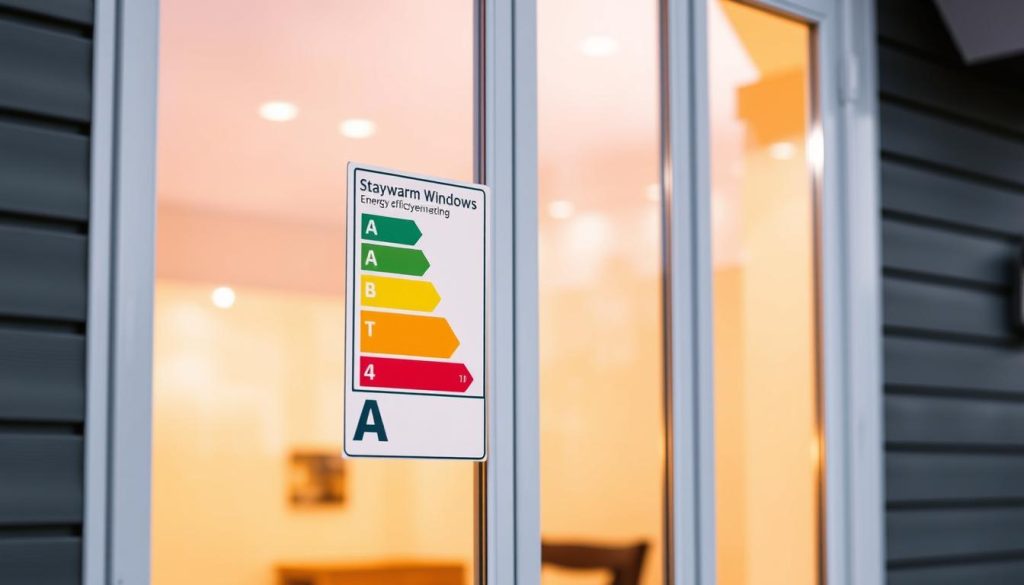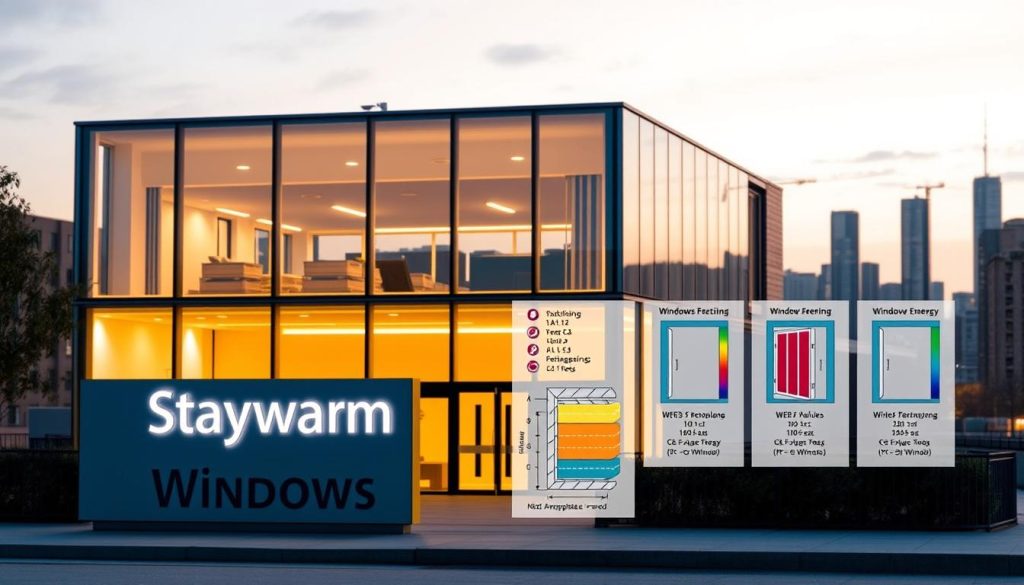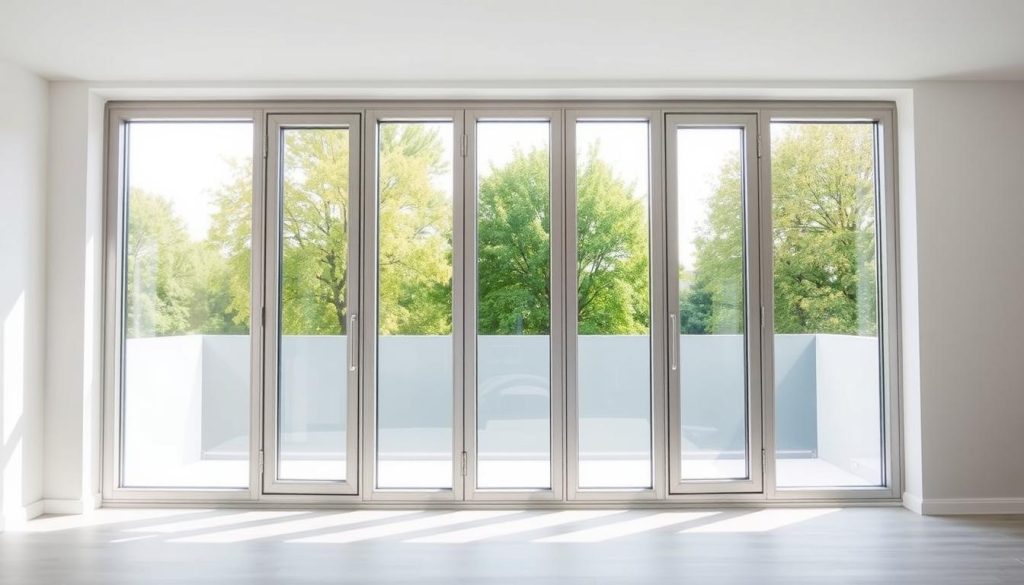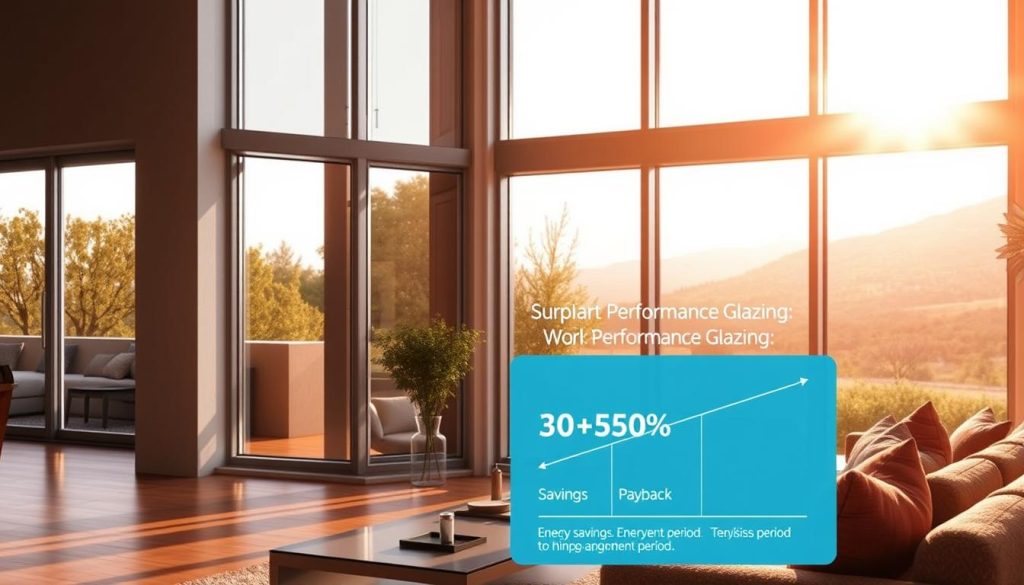Curious which upgrades cut bills and boost your property’s worth?
A Rated Windows are independently tested products that help keep your home warmer by improving thermal efficiency. They use two panes with an argon-filled gap to slow heat loss and reduce draughts.
That simple design can lower energy use and curtail condensation at the edges. For a typical semi-detached house replacing single glazing, savings of around £75 a year are possible. Better glass also helps a property’s EPC and may add to its value when you sell.
This is not just marketing: the British Fenestration Rating Council labels products with a clear Window Energy Rating, so you can compare each rated window with confidence.
In short, choosing higher-performing windows is a practical step to reduce bills, improve comfort and future-proof your home as standards tighten.
Key Takeaways
- They are tested and labelled for energy performance.
- Double glazing with an argon gap boosts thermal efficiency.
- Upgrades can cut household energy bills modestly.
- Good glass supports a stronger EPC and potential value gains.
- Ratings let you compare products beyond vague claims.
Today’s buyer’s guide to A Rated Windows in the UK
This guide helps UK homeowners pick glazing that balances comfort, cost and compliance.
What this guide covers: how to read the rating system, meet current building regulations and weigh style against performance and budget.
Window Energy Ratings use a familiar rainbow label from E up to A++. You can meet building regulations by achieving at least a WER ‘C’ or by hitting the U-value targets introduced in October 2010.
We explain where A sits on the scale and when A+ or A++ might be worth the extra cost. Expect clear, jargon-light facts to help you compare products and estimate likely energy savings.
- How to read ratings and compare windows rated by the BFRC
- Practical compliance tips and showroom questions
- Co-ordinating frames and doors for consistent home performance
| Topic | What you learn | Action |
|---|---|---|
| Rating labels | Rainbow scale, A to A++ and where A sits | Compare labels before choosing |
| Compliance | WER ‘C’ route or U-value targets for regulations | Check certificates and quotes |
| Showroom visits | Questions to ask and what to inspect | Request a no-obligation quote |
What A Rated Windows actually are and how the rating works
Independent lab tests give a clear score that helps homeowners compare glazing options at a glance.
BFRC testing and the Window Energy Rating explained
The British Fenestration Rating Council (BFRC) assesses products using standard tests and issues a window energy rating (WER) label from E to A++.
The scheme balances heat retention, air leakage and useful solar gains so the rating reflects real-world energy performance, not just one metric.
Double glazing construction: panes, argon gas and thermal performance
Typical A level double glazing uses two panes of glass with a sealed cavity filled with argon gas.
The argon slows heat transfer between the warm room and heat outside, and modern coatings plus warm-edge spacers cut losses further.
Recognising the rainbow label and what it tells you
The rainbow label is an easy rating system: letters and colours show overall efficiency so you can benchmark products from different makers.

- Check the actual WER on the product or in the showroom before you buy.
- Remember that frame design and glass coatings influence the final score.
- Higher ratings usually mean better efficiency in everyday use, not just lab figures.
| Factor | What it affects | Why it matters |
|---|---|---|
| Glass & coatings | Heat retention | Improves energy efficiency |
| Gas fill | Heat transfer | Reduces draughts and loss |
| Frame & spacer | Air leakage | Impacts overall rating |
Understanding energy ratings: from E to A++ and the difference between A and A+
Knowing where a product sits on the E–A++ scale helps you match performance to your home’s needs.
The scale runs from E (least efficient) up to A++ (the current top standard). That map shows how well a unit keeps internal heat compared with gains from sunlight across the year.
An A graded option is already very efficient. Over a typical year it will lose roughly the same amount of heat as it gains from solar input.
An A+ product shifts the balance. Under standard test conditions it can admit more heat from outside than it loses, so solar gain improves net performance.
- Orientation and shading affect how much solar gain you actually receive.
- Both A and A+ give strong comfort and energy benefits; choice depends on exposure and budget.
- Check the certified label and ask suppliers what drives the rating before upgrading.
| Scale | Typical behaviour | When to choose |
|---|---|---|
| A++ | Maximises retention and useful solar gain | For best long-term comfort and savings |
| A+ | Net solar gain can exceed losses | Good for sunny, south-facing rooms |
| A | Balances heat loss and gain over the year | Solid, cost-effective upgrade for most homes |
| E–C | Lower retention, less solar advantage | Lower cost but higher running bills |
Building Regulations compliance: WERs versus U-values
Choosing how to prove compliance affects design, comfort and cost.
Two routes meet current building regulations for glazed openings. You can either achieve at least a WER ‘C’ for the completed window unit or meet the Part L U-value targets for thermal transmittance. The October 2010 rules confirmed the WER route as an accepted alternative to U-value calculations for many retrofit and replacement projects.
Key Part L figures to note: the U-value targets are 1.6 W/m²K for windows and 1.8 W/m²K for doors. These numbers set the baseline for heat loss through the glass and frames and are widely used by architects and building control.

How WER and U-values differ
WERs give a rounded picture by including solar gain, air leakage and retained heat. U-values measure only thermal transmittance — the rate of heat loss through the element.
“WERs reflect real-world performance by balancing heat loss with useful solar gain; U-values are precise for insulation performance alone.”
When to favour one route over the other
Solar gain can help in north-facing or shaded rooms where extra passive heating lowers heating demand. But large south-facing glazed areas or conservatories may overheat in summer, so a low U-value is often the safer design choice.
Architects usually specify by U-value for complex builds. Homeowners often find window energy rating labels easier to compare at a glance. Whatever route you choose, ask your installer for documentary proof — a WER certificate or U-value calculation — so building control can sign off the work.
| Compliance route | What it covers | When to use |
|---|---|---|
| WER (minimum C) | Considers heat loss, solar gain and leakage | Everyday replacements; easy label comparison |
| U-value target | Measures thermal transmittance only | Complex builds; tight control on heat loss |
| Design advice | Balance of rating and U-value | Coordinate windows and doors for consistent performance |
The real-world benefits: comfort, energy bills and carbon savings
Better glass and tighter frames deliver comfort gains that you notice without checking a meter.
Cutting heat loss and draughts for a warmer home
Upgraded glazing stops cold spots by the opening and reduces draughts. Rooms feel more stable and you use heating less often.
Lower energy bills through improved energy efficiency
Replacing all single-glazed panes in a typical semi-detached with higher-performing units can save around £75 a year on energy bills.
That saving depends on how you heat your home and your tariff, but it shows how modest upgrades lower running costs.
Reducing carbon emissions with energy efficient glazing
Using less fuel for space heating cuts carbon output. Better energy efficiency directly reduces annual emissions from heating.
Boosting EPC ratings and adding value to your property
Strong energy performance helps lift EPC scores, which matter to buyers and renters and can affect a property’s perceived value.
In some cases, well-chosen glass gives enough solar gain to balance annual heat loss, improving outcomes further.
- Fewer cold spots and draughts for immediate comfort.
- Typical savings: roughly £75/year for a single semi-detached example.
- Lower heating demand reduces spend and exposure to price rises.
- Smaller carbon footprint from reduced energy use.
- Better EPCs can boost buyer interest and property value.
“Upgrading many openings at once magnifies comfort and cost benefits across the whole house.”
Materials and glazing options: choosing style and performance
Your choice of frame and glass sets the balance between style, durability and thermal efficiency.
uPVC, timber-look and aluminium systems
uPVC offers good value and low maintenance and suits standard casement and tilt & turn profiles.
Timber‑look systems give period character while using modern cores for better life and seals.
Aluminium brings slim sightlines and strength, ideal for larger panes like Infinity flush sash or Residence 9 style units.

| Material | Best for | Key benefit |
|---|---|---|
| uPVC | Value replacement | Low upkeep |
| Timber-look | Period homes | Warm appearance |
| Aluminium | Large spans | Slim frames, lasting strength |
Glass choices that shift ratings
Low‑e coatings reflect heat back into the room and improve energy performance. Argon gas in the cavity slows conduction and helps thermal efficiency.
Warm‑edge spacers cut heat loss at the perimeter and reduce condensation risk. These three upgrades move the rating needle more than style alone.
Co‑ordinating openings for consistent comfort
Match frames and sealed unit specs for windows doors and doors so rooms feel even in temperature.
Small spec changes in glass, spacer or coating alter the label. Always ask for the actual WER label for each product variant.
- Common options include casement, vertical sliding sash, tilt & turn and aluminium windows with A or above WER labels.
- Visit a showroom to compare sightlines, hardware and operation before committing.
How to choose the right rated windows for your home
Begin any upgrade by checking certified performance figures rather than trusting sales talk.
Start with the paperwork: compare the window energy rating label and the declared U-value so you understand overall performance and pure insulation. For compliance, remember units can meet building regulations via WER ‘C’ or by hitting the 1.6 W/m²K target for glazing.
Comparing WER labels, U-values and overall energy performance
WER shows balanced gains and losses; U-values show heat transfer alone. Weigh which matters for your exposure and comfort needs. If solar gain helps south-facing rooms, the energy rating may be more useful. In shaded rooms, favour low U-values.
Visiting a showroom and requesting a free, no-obligation quote
Visit a showroom to test operation, check hardware quality and verify that displayed labels match the product quoted. Many installers offer free surveys and no-obligation quotes after inspection.
- Check glass type, gas fill, spacers and frame system on each rated window.
- Ask about guarantees, installation standards and how windows doors will be sealed for airtightness.
- If choosing aluminium, request details of thermal breaks and gasket design.
| Check | Why | Ask for |
|---|---|---|
| Label & U-value | Clear performance picture | Certificate |
| Specification | Determines final rating | Sealed unit details |
| Quote | Fair comparison | Written, like-for-like |
Costs, savings and payback: what to expect
Understanding likely costs and real savings helps you judge whether an upgrade suits your budget and timescale.
Upgrading glazing can cut year‑on‑year heating demand and make rooms feel warmer straight away. As a realistic baseline, replacing all single glass in a typical semi‑detached with modern A‑level double units can save roughly £75 per year on energy bills.
Illustrative savings and variation
Savings vary by property size, window area, orientation and the efficiency of your heating system. In some cases, energy rated units reduce heating and fuel costs by up to 10%.
- Typical saving example: ~£75/yr for a fully single‑glazed semi‑detached.
- Higher savings: larger homes or inefficient boilers may see bigger percent reductions.
- Lower savings: small flats or low heating use mean longer payback.
What affects price and payback
Cost drivers include frame choice (uPVC is cheaper; premium timber‑look and aluminium cost more), sealed unit specification and installation complexity. Installation quality is crucial—poor fitting increases air leakage and thermal loss, cutting payback.

“Consider lifetime cost: durability, maintenance and guarantees, as future energy price rises will affect payback.”
| Driver | Effect | Why it matters |
|---|---|---|
| Frame material | Upfront cost | Impacts longevity and thermal performance |
| Glass spec | Energy efficiency | Drives the energy rating and heat loss |
| Installation | Real‑world performance | Controls air tightness and long‑term value |
A Rated Windows
Opting for well-specified glazed systems gives lasting comfort and aligns with tightening building standards.
Why they’re a smart, future-proof choice for UK homes
Top-level glazing is among the best-performing options for thermal comfort and reduced heat loss. Many systems across uPVC and aluminium reach this energy grade or better.
They meet current building regulations and so give you confidence your upgrade will stand up to future rules. That helps with long-term planning and resale prospects.
- Comfort: steadier indoor temperatures and less noise.
- Compliance: aligns with building and certification expectations.
- Style choice: from sleek aluminium windows to classic frames, you can match doors and facades.
- Running costs: lower energy use can reduce energy bills over time.
- Value: stronger EPCs and visible performance appeal to buyers.
“Invest once and invest well: choose certified systems with clear warranties and reliable service.”
| Benefit | What it means | How it helps |
|---|---|---|
| Thermal performance | Better retention of heat | Lower heating demand and improved comfort |
| Regulatory fit | Meets building regulations | Smoother approvals and future resilience |
| Material range | uPVC, aluminium and timber-look | Match aesthetic and maintenance needs |
| Resale impact | Improved EPC and buyer appeal | Potential uplift in property value |
Conclusion
Certified energy-efficient glazing gives clear, test-backed benefits for comfort and running costs.
High-performing units cut heat loss, boost comfort and can lower bills while improving energy credentials. Check the WER label and, where relevant, declared U-values so you know what performance to expect.
Choose matching frames and sealed units across your windows and door openings so the whole house works together. Ask for the certified label on each product and request a written quote you can compare.
Shortlist styles and materials that suit your home, then pick the certified option that balances budget and long-term value for your property.



